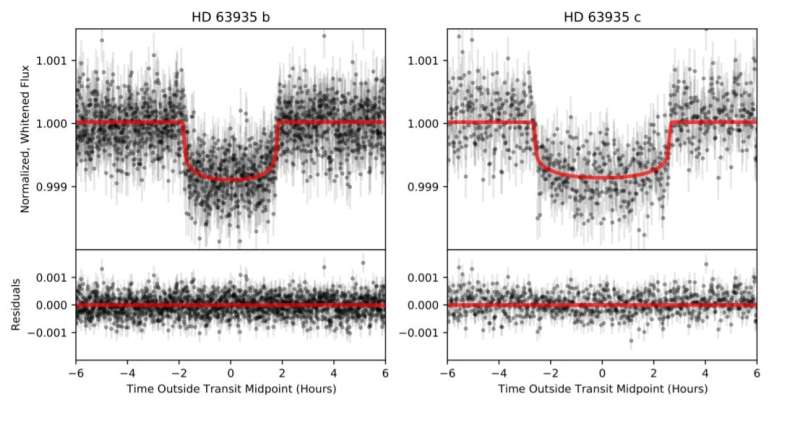Astronomers discover twin sub-Neptune exoplanets orbiting nearby star

By analyzing the data from the TESS-Keck Survey (TKS), an international team of astronomers reports the detection of two almost identically sized sub-Neptune exoplanets orbiting a nearby star. The newly found alien worlds, designated HD 63935 b and HD 63935 c, are about three times larger than the Earth. The finding is detailed in a paper published October 13 on the arXiv pre-print server.
NASA’s Transiting Exoplanet Survey Satellite (TESS) is conducting a survey of about 200,000 of the brightest stars near the sun with the aim of searching for transiting exoplanets. So far, it has identified over 4,500 candidate exoplanets (TESS Objects of Interest, or TOI), of which 161 have been confirmed so far.
TKS performs precise radial velocity (PRV) follow-up observations of TESS planet candidates using the Keck telescope on Mauna Kea, Hawaii and the Automated Planet Finder (APF) telescope at Lick Observatory, California. It is the largest collaborative effort in the northern hemisphere to measure precise masses and orbits of over 100 TESS-identified exoplanets.
As part of TKS, a group of astronomers led by Nicholas Scarsdale of the University of California, Santa Cruz, has now confirmed that two sub-Neptune are transiting a nearby bright sun-like star known as HD 63935 (other designations HIP 38374 and TIC 453211454).
“In this paper, we present the confirmation of the subNeptune planets HD 63935 b and c,” the researchers wrote.
According to the study, HD 63935 b has a radius of approximately 2.99 Earth radii, while its mass is estimated to be some 10.8 Earth masses. This gives a density at a level of 2.2 g/cm3. The planet orbits HD 63935 every 9.06 days and its equilibrium temperature is 911 K.
HD 63935 c has a radius of about 2.9 Earth radii but is more massive than its companion—the mass was measured to be around 11.1 Earth masses. Hence, the exoplanet has a density of some 2.5 g/cm3. HD 63935 c has an orbital period of 21.4 days and equilibrium temperature of approximately 684 K.
The host star HD 63935 is about 6.8 billion years old and is slightly smaller than the sun. It has a radius of about 0.96 solar radii and a mass of around 0.93 solar masses. The star has a metallicity of approximately 0.07, its luminosity is at a level of 0.8 solar luminosities, and its effective temperature was estimated to be 5,534 K.
The researchers noted that the newly detected planets are excellent targets for further atmospheric studies.
“HD 63935 b and c attest to the bright future of exoplanet astronomy and we expect this system to be an excellent test case for studying exoplanetary atmospheres in coming years,” the authors of the paper concluded.
Astronomers discover an inflated ‘hot Jupiter’
Nicholas Scarsdale et al, TKS V. Twin sub-Neptunes Transiting the Nearby G Star HD 63935. arXiv:2110.06885v1 [astro-ph.EP], arxiv.org/abs/2110.06885
© 2021 Science X Network
Citation:
Astronomers discover twin sub-Neptune exoplanets orbiting nearby star (2021, October 20)
retrieved 20 October 2021
from https://phys.org/news/2021-10-astronomers-twin-sub-neptune-exoplanets-orbiting.html
This document is subject to copyright. Apart from any fair dealing for the purpose of private study or research, no
part may be reproduced without the written permission. The content is provided for information purposes only.
For all the latest Science News Click Here
For the latest news and updates, follow us on Google News.

